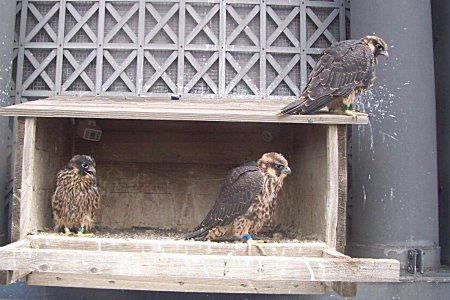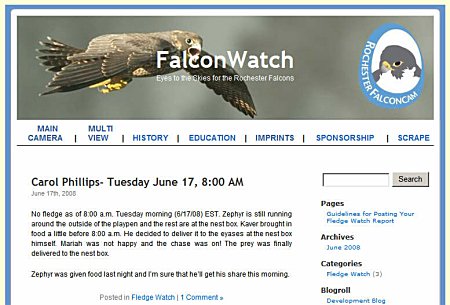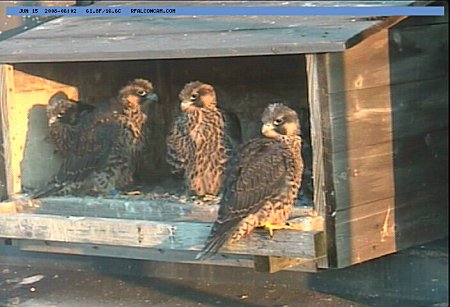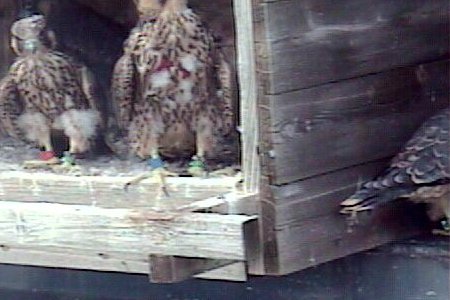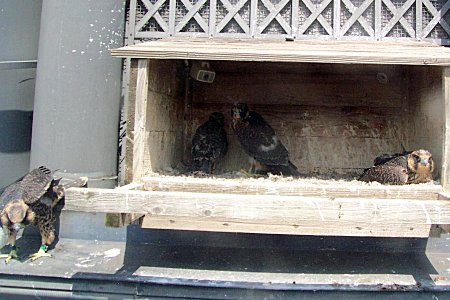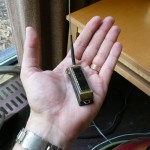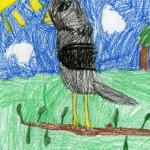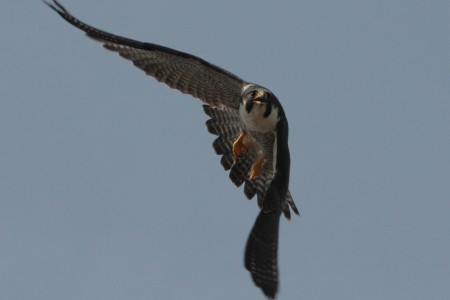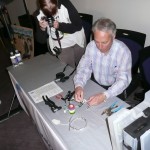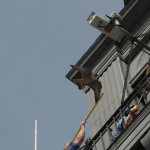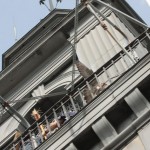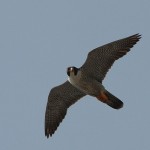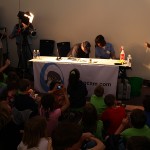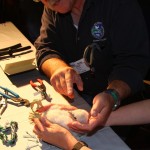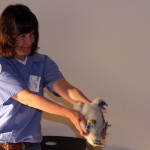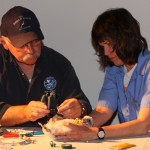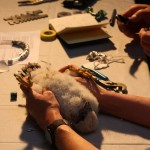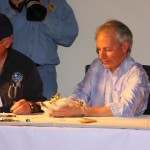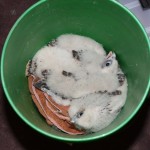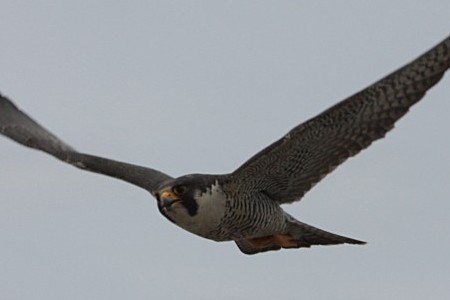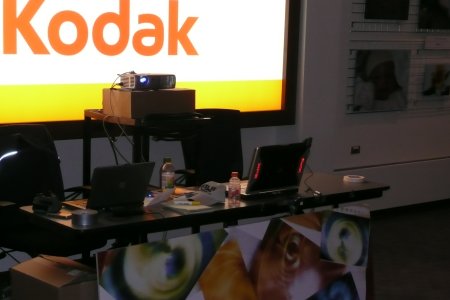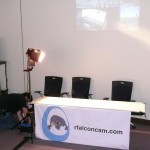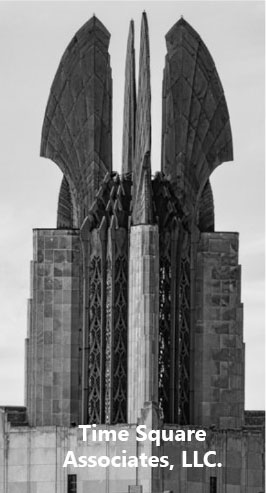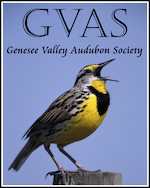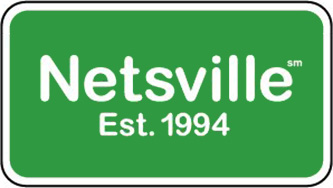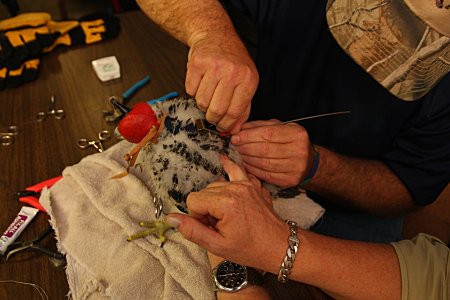
Today, with the help of the New York State Dept. of Environmental Conservation, we fitted Quest with a solar-powered satellite transmitter. Her stylish new high-tech gear will help us to track her movements after she leaves the nest box. Quest was chosen to carry the transmitter during last week’s Banding Day. Mike Allen and Barbara Loucks of the DEC found her to be the biggest of the eyases, which will give her an advantage when carrying the 22-gram transmitter.
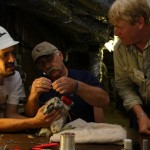
Mark Nash of the Canadian Peregrine Foundation came from Toronto to lend his expertise, while Mike Allen got to play tailor, sewing the neoprene harness that holds the transmitter. Rochester Falconcam team members Kenn Martinez and Jim Pisello offered their assistance throughout the two hour procedure, and captured pictures as the work progressed. The team ran into a bit of trouble when they found their can of neoprene cement had solidified, but not to worry! They found an able substitute: Mexican Red ladies’ nail polish! The team used it to seal the knots in the heavy nylon thread (otherwise known as mint dental floss!) that secures the transmitter to the harness. The colorful nail polish turned out to be a good match for the harness color too! To keep Quest calm during the procedure, she got to wear a red falconer’s hood, and it worked. She went through the fitting with only a couple of squawks.
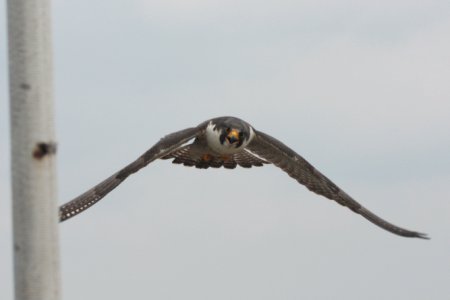
With the transmitter in place, Quest was returned to the nest box. As you can imagine, Mariah wasn’t too happy that her daughter had been eyas-napped, and she let the transmitter team hear her displeasure with lots of kacking and aggressive fly-bys. As Quest’s feathers continue to grow she’ll preen them around the harness, and it won’t interfere with her flying, hunting or eating. As soon as she starts moving around, we’ll plot her travels on a map so that everyone will be able to follow her as she “peregrinates”, or wanders on her own quest for adventure!
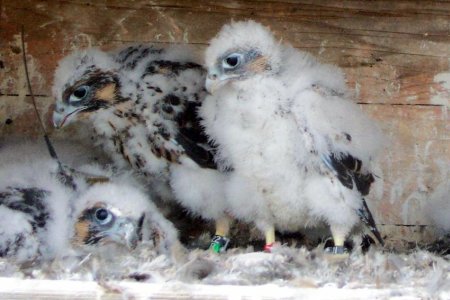
UPDATE
We’ve fitted transmitters to several of the Rochester falcons in past years. They always generate a lot of interest, a lot of questions, and some concerns, so I thought I’d take a moment to provide a little more information about them.
The modern satellite transmitter for a Peregrine weighs less than 5% of the Peregrine’s total mass. This 22 gram transmitter was fitted to the largest of this year’s females, Quest. We haven’t weighed her, but female eyases at fledging usually weigh somewhere around a kilogram or so. The transmitter and harness are about 2% of her fledging body weight. These birds will shortly be carrying food brought to them by their parents that will weigh hundreds of grams, so the weight of the transmitter is inconsequential to the fledgling’s ability to fly, hunt, or perform any of the normal functions you’d expect from a Peregrine including mating and raising a family.
Why fit a transmitter at all? Well, it turns out that even though Peregrines have made a remarkable comeback from the brink of extinction by moving into urban environments, we don’t actually know a lot about the migration patterns of these urban-raised Peregrines. Leg bands can be helpful, but they’re only useful if you can actually get close enough to read them. For a falcon on the wing that’s nearly impossible. During a migration the only way to read a band would be to capture the migrating bird every few days along its route. If you think about what it would take to actually do that in terms of time, people, and other resources, you can see that the odds are pretty small for getting any useful data that way.
The great advantage of a transmitter is that we never have to touch, see, or interact with the falcon at all in order to follow its movements. We’ll be able to get updates every few days showing the bird’s actual location, so we can plot its travels over time. This provides the potential to learn more than we ever could about migratory patterns, even from many hundreds of banded birds.
Since Mariah has been nesting in Rochester, four of her offspring have worn transmitters. Unfortunately, none survived their first year of life. At first glance, it might seem that the transmitter acted as some kind of hindrance to the birds, but that’s really not the case. Studies of captive birds wearing transmitters have shown no difference in their behavior, flight or hunting capabilities once they have adjusted to the transmitter. In Quest’s case, she’s ahead of the game because she’ll be wearing it beginning with her first flight.
The simple fact, as we have pointed out many times here at Imprints, is that the first year of life is hard for Peregrines, and many just don’t survive. In this year’s group, it is likely that three or more will not survive their first year. Of Mariah’s 38 fledglings from 1998 to 2007, we know the whereabouts of only 5. We know of the deaths of 7. So taken together, we know the status of less than 1/3 of her fledged offspring. It is likely that many more failed to survive than the seven we know of. So 4 out of 43 eyases have had transmitters. That’s fewer than 10% of Mariah’s offspring. Since the first year survival rate is something less than 50%, it is not surprising that all of the falcons fitted with transmitters have died. The two whose circumstances we know about– Hafoc and Skye– both had causes of death that had nothing to do with their transmitters. Hafoc was hit by a car, and Skye was the victim of a predator. 2001’s Mary Ann got a transmitter after she was rescued from the street and spent several weeks recovering. Her transmitter stopped working near Braddock Bay during the fall of that year. Given the time and her position, it is likely that she too fell victim to a predator, most likely a Great Horned Owl, many of which are found in the woodlands around the bay.
Finally, I’d like to repeat that the first priority of the New York State Department of Environmental Conservation, Genesee Valley Audubon Society, and the Rochester Falconcam, is the safety and well-being of Mariah, Kaver and all their offspring. We have invested much of our lives, time and effort to maximize the chances for their prosperity. We won’t do anything to jeopardize these marvelous creatures or their success.
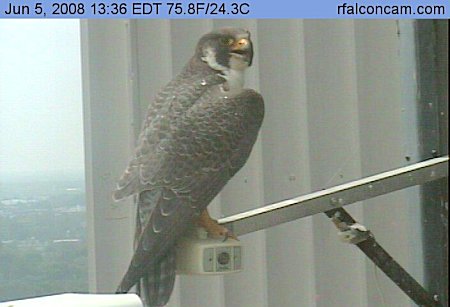
-Jess
